Track workouts are the most effective way to build explosive running speed and improve your overall performance.
Whether you’re a sprinter, distance runner, or simply want to move faster, incorporating speed sessions on the track helps you strengthen your fast-twitch muscle fibers, boost VO₂ max, and sharpen your running mechanics.

Training on a track provides a safe, measured environment to time intervals accurately, control recovery, and push pace safely — which is why it’s trusted by elite and recreational runners alike.
Why Track Workouts Matter for Speed
According to Runner’s World (2024), speed workouts such as 200 m and 400 m intervals can improve your stride efficiency and pacing rhythm, while Harvard Health Publishing (2025) notes that short-duration, high-intensity sprints build both anaerobic capacity and leg power.
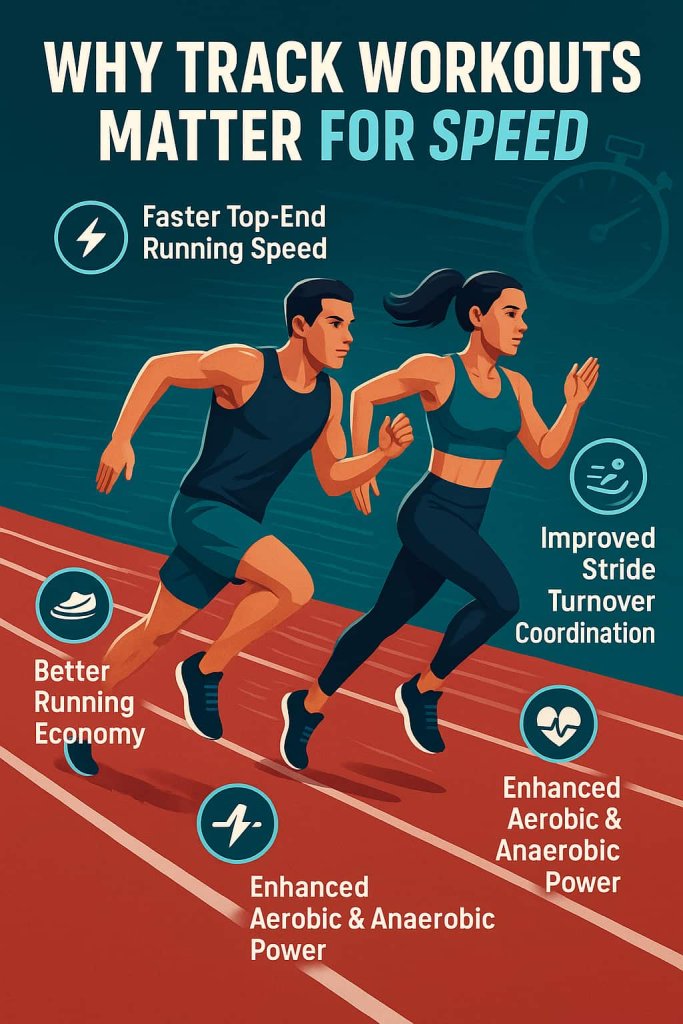
Key benefits include:
- Faster top-end running speed
- Better running economy (using less energy per stride)
- Improved muscle coordination and stride turnover
- Enhanced aerobic and anaerobic conditioning
The track’s flat, predictable surface allows you to measure every second and meter — a crucial advantage for structured training and performance gains.
How Often Should You Do Track Workouts?
For most runners, 1–2 track sessions per week is ideal.
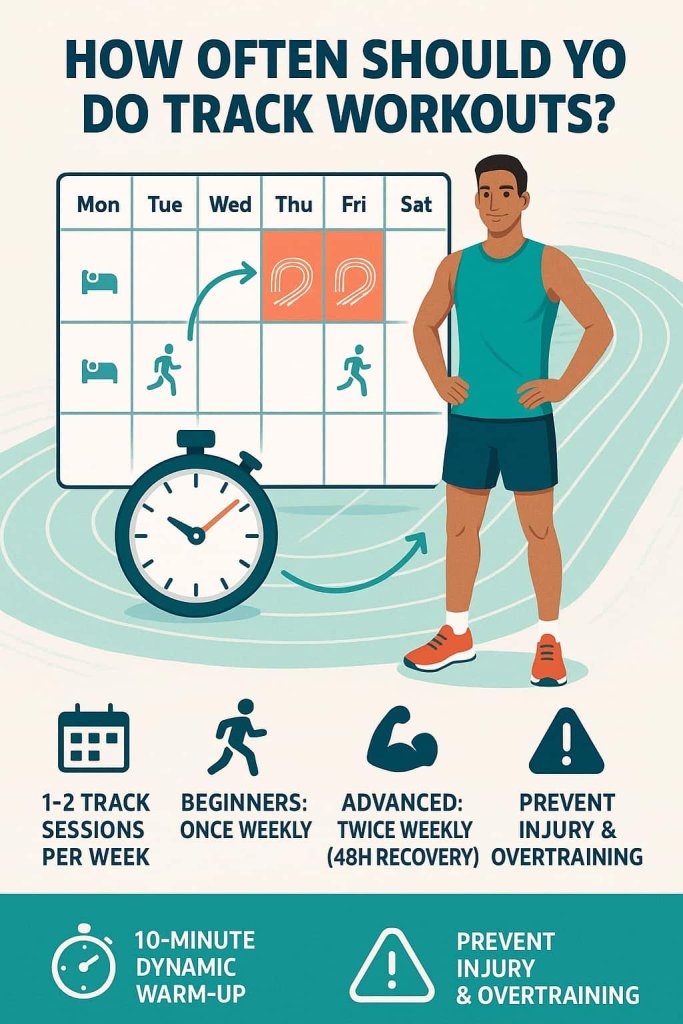
- Beginners: once weekly to start
- Intermediate/advanced: twice weekly (with at least 48 hours of recovery between sessions)
Always include a 10-minute dynamic warm-up before sprinting — jogging, high knees, butt kicks, and strides — to reduce injury risk.
10 Best Track Workouts for Speed
Below are ten research-supported and coach-approved sessions that target speed, endurance, and explosive power.
1. 200 m Repeats
Why it works:
Short 200 m bursts are one of the most efficient ways to train acceleration, stride frequency, and turnover speed. They target the body’s anaerobic energy system, forcing fast-twitch fibers to fire rapidly and powerfully. Consistent 200 m intervals improve how quickly you reach top speed and how efficiently you maintain it.
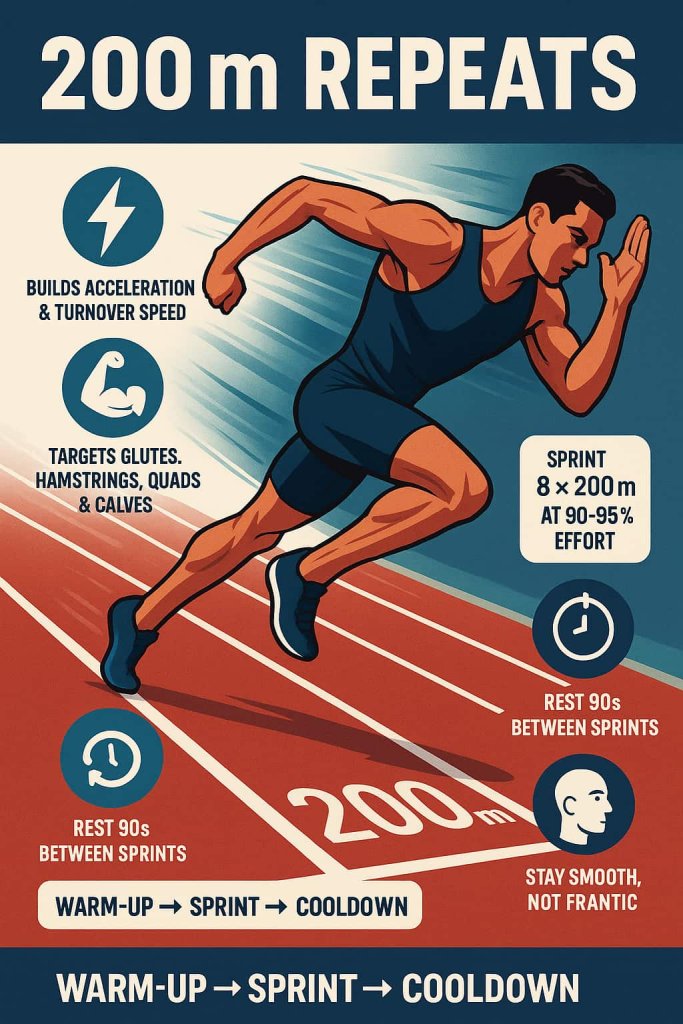
Muscles worked:
Glutes, hamstrings, quadriceps, calves, hip flexors, and core stabilizers.
How to do it:
- Warm up with 10 minutes of light jogging, dynamic stretches, and 4 × 50 m build-up runs.
- Sprint 8 × 200 m at 90–95 percent effort.
- Rest 90 seconds between sprints (walk or light jog).
- Maintain upright posture, relaxed arms, and quick ground contact.
- Finish with a 5-minute cooldown jog.
Trainer Tip:
If new to sprints, start with 4–5 reps and add one rep weekly. Stay smooth — sprinting should feel powerful but controlled, not frantic.
2. 400 m Intervals
Why it works:
The classic quarter-mile interval builds both speed endurance and mental toughness. Running near your 5 K pace pushes your lactic threshold, helping your muscles handle fatigue and maintain power longer.
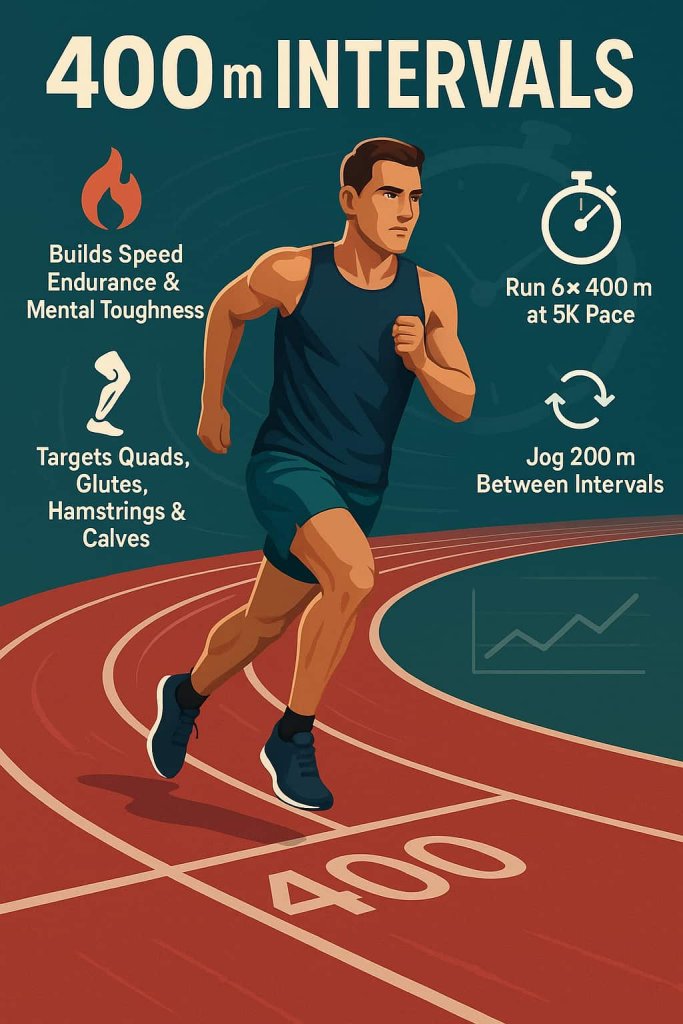
Muscles worked:
Quadriceps, glutes, hamstrings, calves, and abdominal stabilizers.
How to do it:
- Run 6 × 400 m at 5 K pace or slightly faster.
- Jog 200 m between intervals for recovery.
- Keep breathing rhythmic — in through the nose, out through the mouth.
- Maintain consistent effort across all reps.
Trainer Tip:
Keep splits within ± 2 seconds of each other. This consistency trains your body to hold a fast, even pace over long races.
3. 800 m Repeats
Why it works:
Longer intervals like 800 m build aerobic strength and sustained race power. They simulate tempo running while still challenging your cardiovascular system with speed. Perfect for distance runners wanting to sharpen pace control.
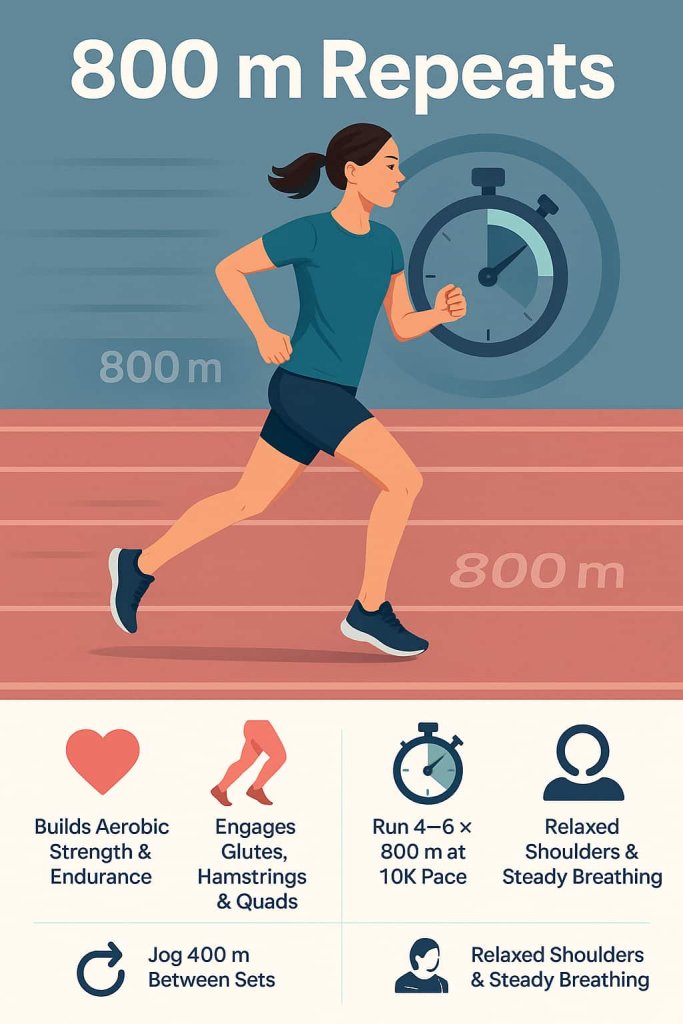
Muscles worked:
Glutes, hamstrings, quadriceps, calves, core, and lower back.
How to do it:
- Warm up fully, then run 4–6 × 800 m at 10 K race pace.
- Jog 400 m between sets.
- Focus on relaxed shoulders and steady breathing rhythm.
Trainer Tip:
Use these mid-season or before races. Keep the first rep controlled — finishing faster than you start trains stamina and composure.
4. Ladder Workout (200 m → 400 m → 600 m → 800 m → 600 m → 400 m → 200 m)
Why it works:
Ladder intervals build speed, endurance, and mental resilience by gradually increasing and then decreasing distance. This design mimics racing conditions, teaching your body to push through fatigue and recover while maintaining efficiency.
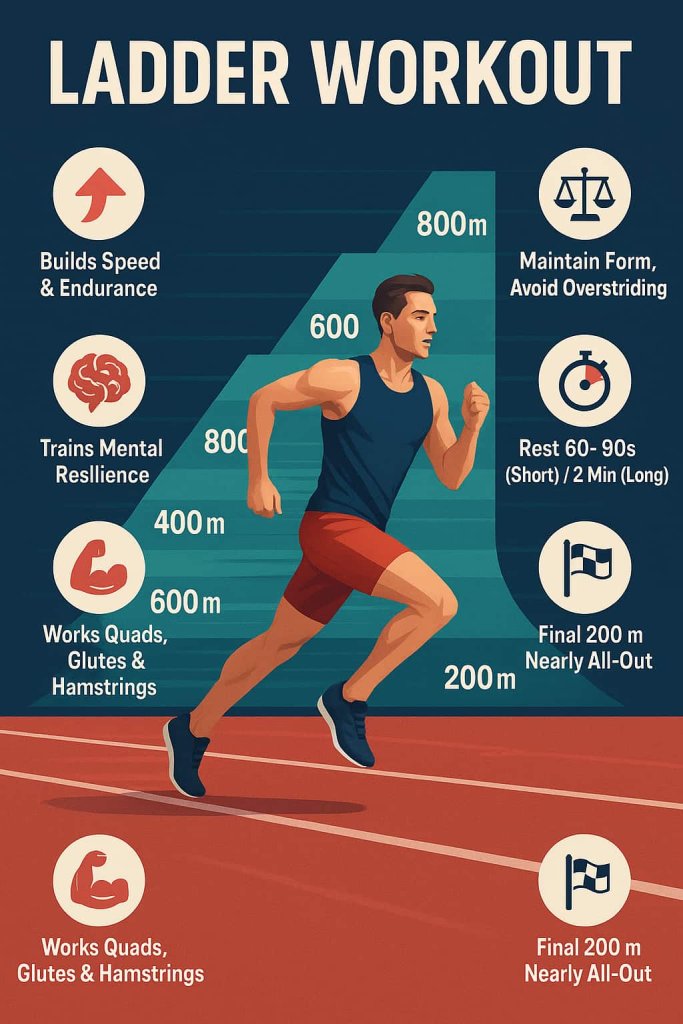
Muscles worked:
Quads, glutes, hamstrings, calves, hip flexors, and abdominals.
How to do it:
- Start with 200 m and progress up to 800 m, then descend back down.
- Rest 60–90 seconds after short runs, 2 minutes after longer ones.
- Keep your form steady throughout; avoid overstriding.
Trainer Tip:
Run the 800 m segment at tempo pace and the final 200 m nearly all-out. This contrast enhances both aerobic efficiency and sprint finish speed.
5. 30-20-10 Sprint Protocol
Why it works:
A scientifically proven sequence combining aerobic and anaerobic stress. By alternating low, moderate, and high intensity within one minute, you maximize calorie burn and sprint efficiency while minimizing total workout time.
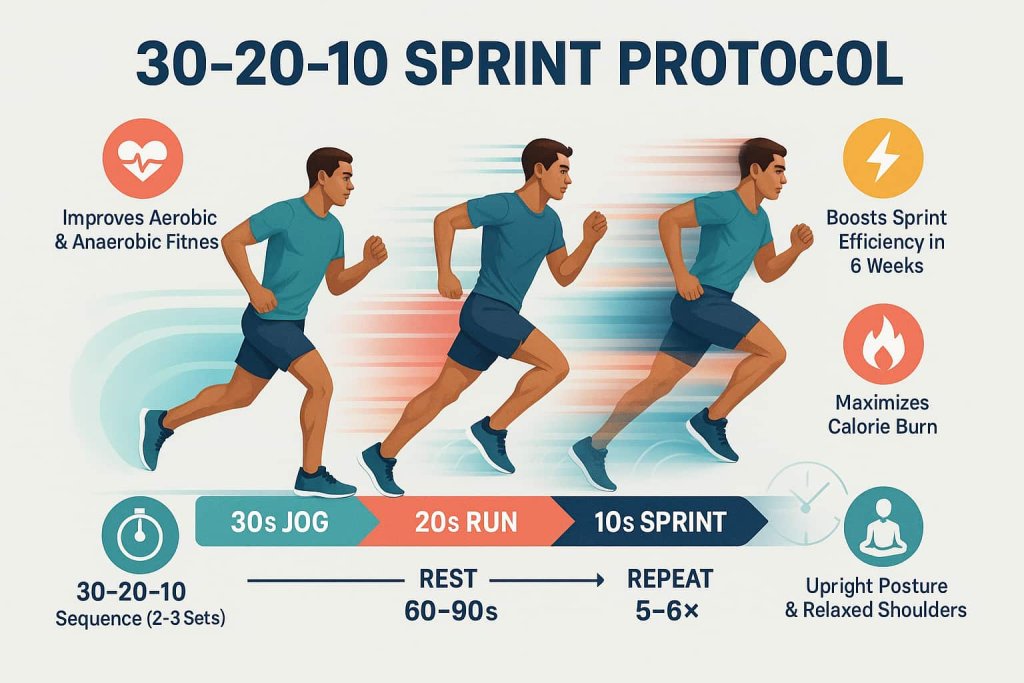
Muscles worked:
Glutes, hamstrings, calves, hip flexors, and core stabilizers.
How to do it:
- Jog 30 seconds, run 20 seconds, sprint 10 seconds.
- Rest 60–90 seconds and repeat 5–6 rounds.
- Perform 2–3 sets total depending on fitness level.
Trainer Tip:
Use an interval timer to stay precise. Keep form solid during sprints — upright posture and relaxed shoulders make each 10-second burst count.
6. Flying Sprints (Build-Ups)
Why it works:
Flying sprints develop maximum velocity mechanics without the strain of hard starts. You learn to accelerate gradually and maintain top speed with perfect form, ideal for improving turnover and neuromuscular coordination.
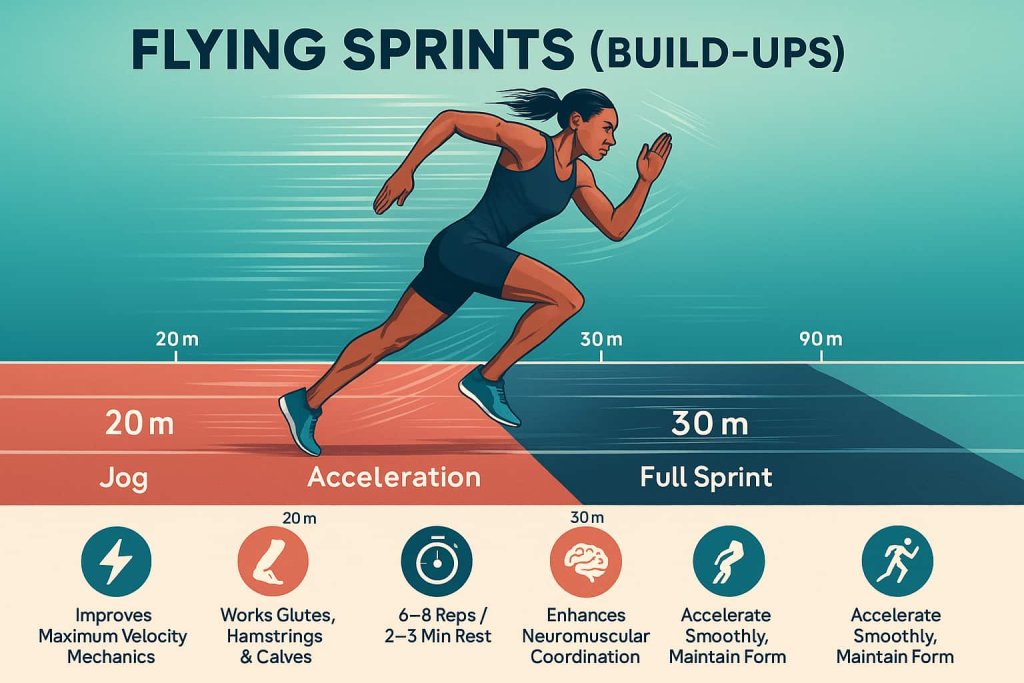
Muscles worked:
Hamstrings, glutes, calves, hip flexors, and upper-body stabilizers.
How to do it:
- Start with a 20 m jog, then smoothly accelerate for 20 m until at full sprint.
- Hold top speed for 30 m and decelerate 20 m.
- Complete 6–8 reps with 2–3 minutes of rest between.
Trainer Tip:
Perform these early in a session when fresh. Quality matters — every stride should feel fast, light, and powerful.
7. Pyramid Intervals
Why it works:
Pyramids train both endurance and recovery control. Alternating distances forces your heart rate to fluctuate, which enhances cardiovascular adaptability and mental pacing.
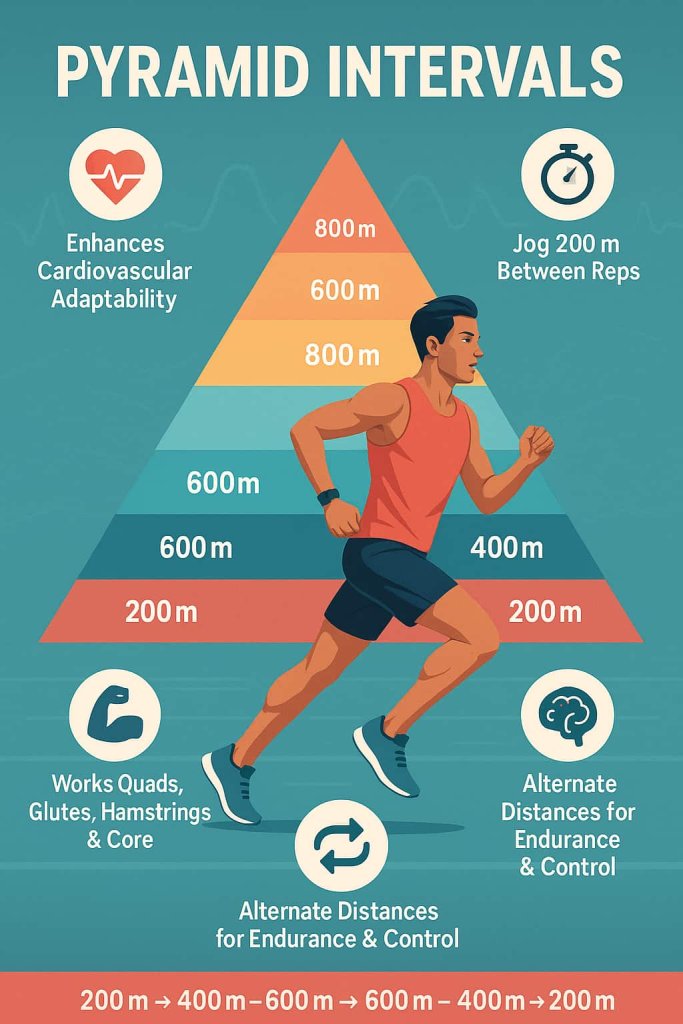
Muscles worked:
Quads, glutes, hamstrings, calves, abs, and spinal stabilizers.
How to do it:
- Run 200 m, 400 m, 600 m, 800 m, 600 m, 400 m, 200 m.
- Jog 200 m for recovery between reps.
- Maintain even effort — avoid sprinting early reps.
Trainer Tip:
Visualize each segment as a gear shift. Smooth transitions in pace build the control needed for strong race finishes.
8. Sprint Straights, Jog Turns
Why it works:
An approachable workout for all levels. Alternating between sprints and easy jogs improves speed turnover, aerobic base, and recovery tolerance while staying joint-friendly.
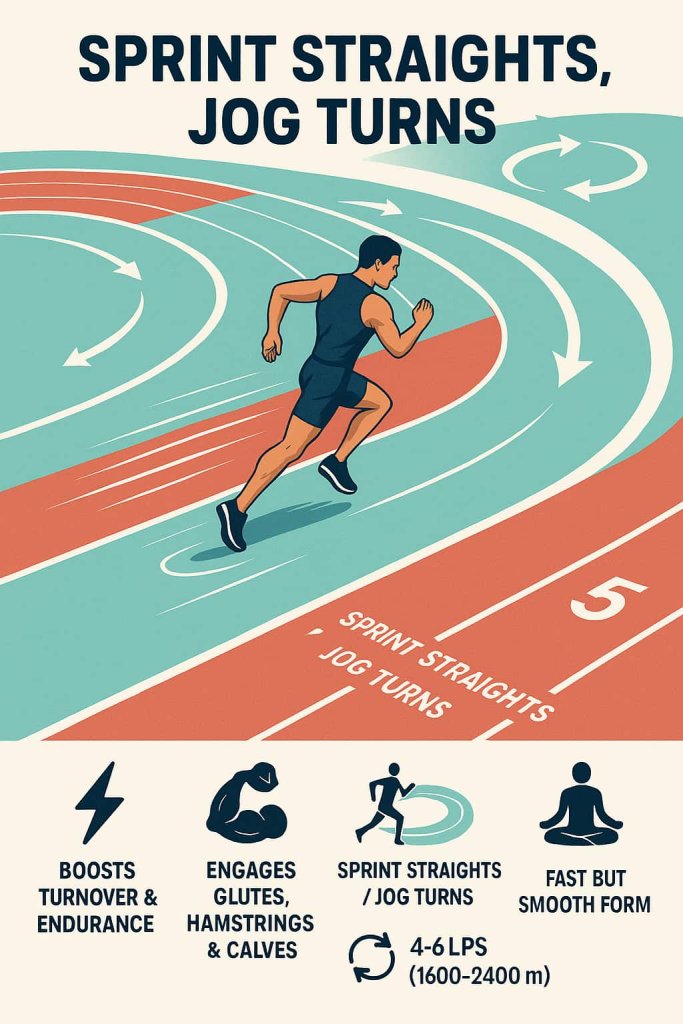
Muscles worked:
Glutes, hamstrings, calves, hip flexors, and core.
How to do it:
- On a 400 m track, sprint the straights (100 m) and jog the curves (100 m).
- Complete 4–6 laps (1600–2400 m total).
- Keep sprints sharp and relaxed.
Trainer Tip:
Think “fast but smooth.” Use this workout as an introduction to speed work or an aerobic maintenance session between heavier sprint days.
9. Hill Bounding Sprints (Off-Track Option)
Why it works:
Uphill sprinting develops explosive leg drive, ankle stiffness, and stride power with less joint impact than flat sprints. The incline naturally corrects poor mechanics, teaching you to lean forward and engage your glutes fully.
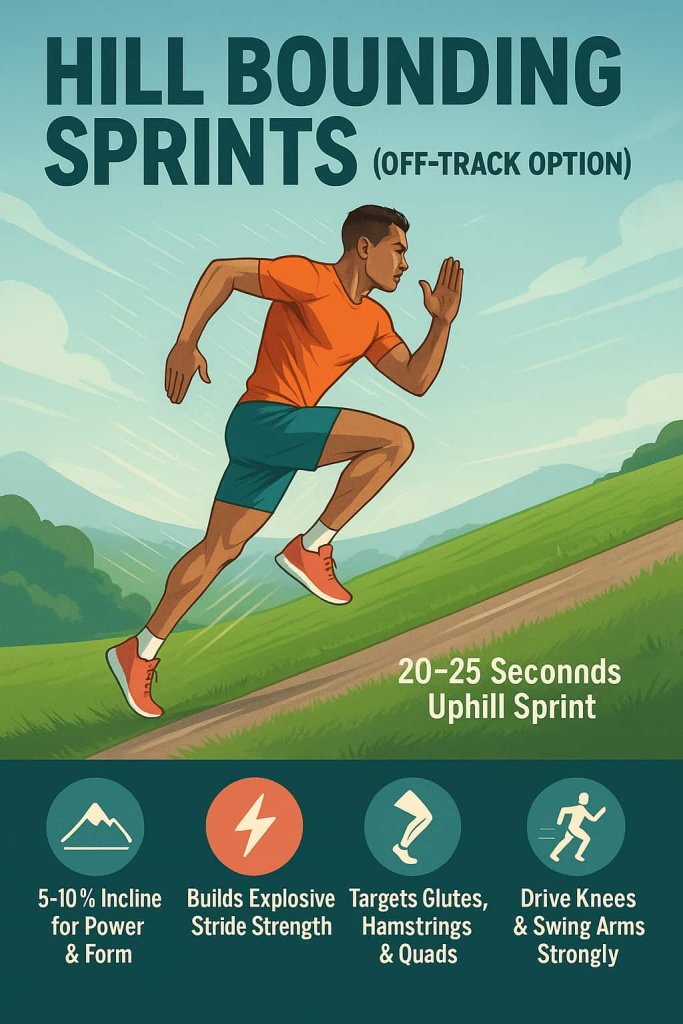
Muscles worked:
Glutes, hamstrings, calves, quads, and core.
How to do it:
- Find a hill with a 5–10 percent incline.
- Sprint uphill for 20–25 seconds, driving knees high.
- Walk down for full recovery.
- Perform 6–8 rounds.
Trainer Tip:
Focus on powerful arm swings and mid-foot landings. Perform this workout once per week to build raw strength for faster flat-ground sprints.
10. 10 × 100 m Speed Session
Why it works:
This pure speed workout sharpens reaction time, coordination, and neuromuscular firing patterns. The short distances emphasize perfect form, acceleration, and maximal velocity — crucial for anyone wanting faster starts or finishes.
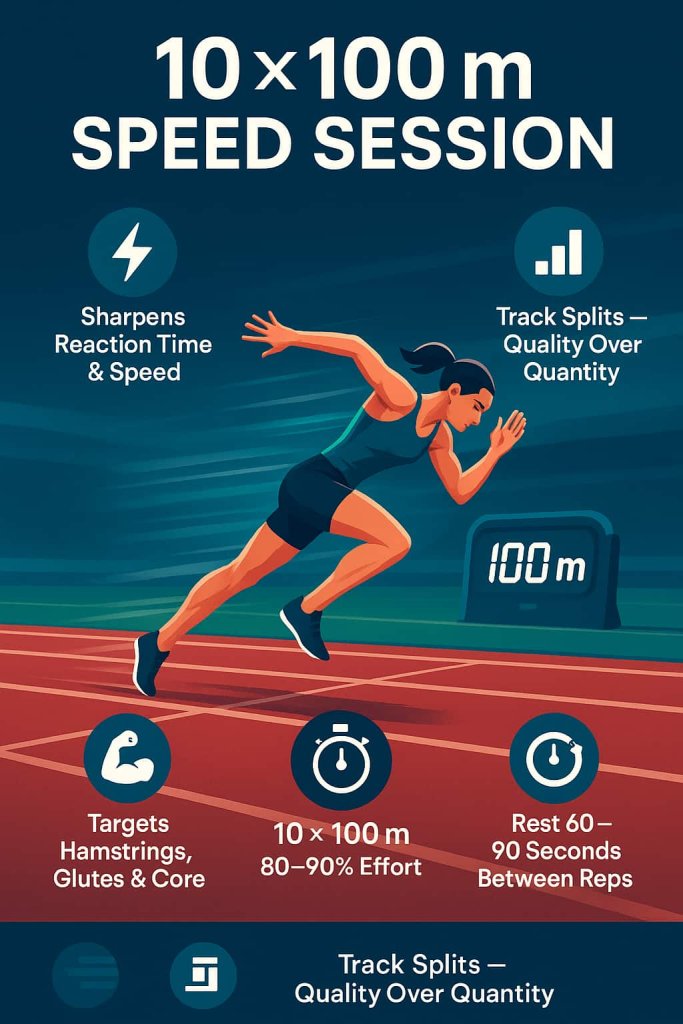
Muscles worked:
Hamstrings, glutes, calves, shoulders, and core.
How to do it:
- Sprint 10 × 100 m at 80–90 percent effort.
- Rest 60–90 seconds between reps.
- Keep stride long, quick, and controlled.
Trainer Tip:
Record times each rep. If speed drops > 10 percent, rest longer or end the session — quality output trumps volume in speed training.
Safety and Recovery Tips
- Warm-up thoroughly before sprinting.
- Cool down with light jogging and stretching.
- Avoid back-to-back speed days.
- Track your splits to monitor progress.
- Include strength training (glutes, hamstrings, core) for injury prevention.
Example Weekly Schedule
| Day | Focus | Workout Type |
|---|---|---|
| Monday | Easy run | 3–5 miles relaxed |
| Tuesday | Track Speed Session | 200 m repeats |
| Wednesday | Strength / Mobility | Gym or body-weight |
| Thursday | Recovery | Light jog or rest |
| Friday | Track Power Session | 400 m or ladder workout |
| Saturday | Cross-training | Cycling, pool, or mobility |
| Sunday | Rest | Full recovery |
Frequently Asked Questions
1. How long should a track workout last?
Most sessions take 20–45 minutes, including warm-up and cooldown.
2. Are track workouts only for sprinters?
No. Even marathoners benefit from short intervals to improve efficiency and pacing.
3. Can I do these workouts on a treadmill?
Yes — adjust distances or time intervals, but keep the same intensity ratios.
4. What shoes are best for track workouts?
Use lightweight trainers or track spikes designed for short-distance running.
5. How soon will I see results?
With consistent training (2× per week), noticeable speed gains often appear within 4–6 weeks.
6. What if I’m new to speed work?
Start with fewer reps (3–4) and longer rest periods. Build volume gradually.
7. Do I need a coach for track training?
Not necessarily, but using a timer or GPS watch helps track progress and form consistency.
Conclusion
Track workouts remain one of the most effective, time-efficient ways to get faster and build explosive running power. Whether you’re chasing a personal best or simply want to feel stronger and more athletic, incorporating these ten structured sessions will transform your speed, stamina, and confidence.
Ready to run faster? Start with one workout this week, and track your times — consistency will deliver results you can feel and measure.
